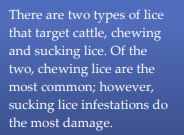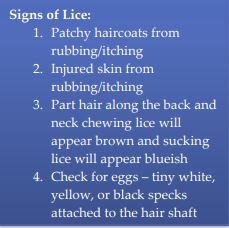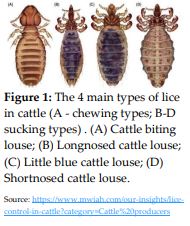
Just when we get relief from summer flies, we run into a winter problem. Lice.
Lice spread by direct contact, herd-mates in close quarters and mothers to calves. Lice do not live long when separated
from their host. While lice can infest cattle year-round, numbers are usually lower in summer due to winter coats
shedding and the elevated temperatures associated with the summer sun. The thick winter hair coat provides the perfect
environment for lice to reproduce. Their lifecycle is 20 – 30 days with all stages
occurring on the host animal. Adult female lice lay their eggs attaching them to
the hair shaft. Eggs hatch within 5 – 14 days. The emerging nymphs look like
small adults and will undergo 3 molts within a week. They will begin laying
their own eggs about 2 weeks after that

Summer provides some relief from lice as they do not tolerate heat well. Lice can
handle temperatures up to about 104⁰F before they perish. Come spring, lice will
either die off or move to cooler parts of the host. Typically, we begin to see die off
begin around March when the days get longer, and the sunlight becomes more intense. Relying on the change of seasons
should not be our approach to lice control. There are more strategies available to us to pursue. First, a solid nutrition
program is crucial. Healthy, well-fed cattle are more resistant to lice. Pour-on insecticides are also available and can be
very effective. Ivermectin pour-on formulas are effective against both chewing and biting lice (injectable is not).
Pyrethroid pour-ons are also effective against both types. Products such as avermectins, moxidectin, and eprinomectin
are mostly effective against sucking lice. When using a pour-on, it is crucial that the product makes it down to the skin
and doesn’t simply sit on top of the haircoat. Many products rely on skin oils
to spread the insecticide over the body. If the product is sitting on the haircoat
it cannot spread, nor is it even reaching where the lice are located.

Lice treatments should ideally be done in fall prior to cattle being moved into
closer quarters. If lice recur later in winter, retreatment is indicated. These
treatments often also provide control for other external parasites (such as
ticks), and some products control internal parasites/worms as well. Timing is
key for lice control. Treating too early (August/September) offers more time
for lice populations to rebuild. Treating on time (October/November) is more
effective; however, all cattle should be treated twice for maximum protection.
Without a second treatment (given about
3 weeks after the first treatment),
residual lice can repopulate. Also,
treatments are only effective against the
adult louse, the eggs will remain unharmed. Once they hatch, they can quickly
reproduce and spread without intervention. Ensure all animals are treated and at
the maximum level. Any untreated or undertreated animals will become the
breeding grounds for reinfestation. In addition to pour-on treatments, backrubbers
and dust bags can be used for self-treatment of animals.

Young animals and older, undernourished cattle tend to have the heaviest lice
populations. Younger animals usually develop some resistance after their initial
exposure. However, some animals never develop this and end up being carrier
animals that need to be culled from the herd.

